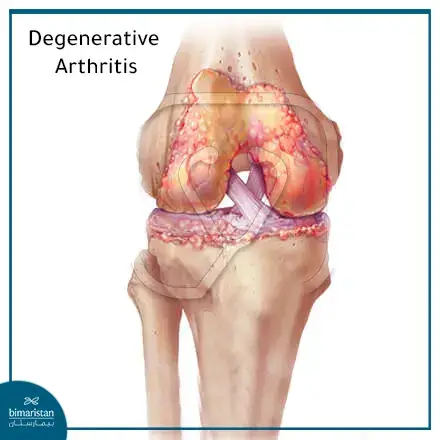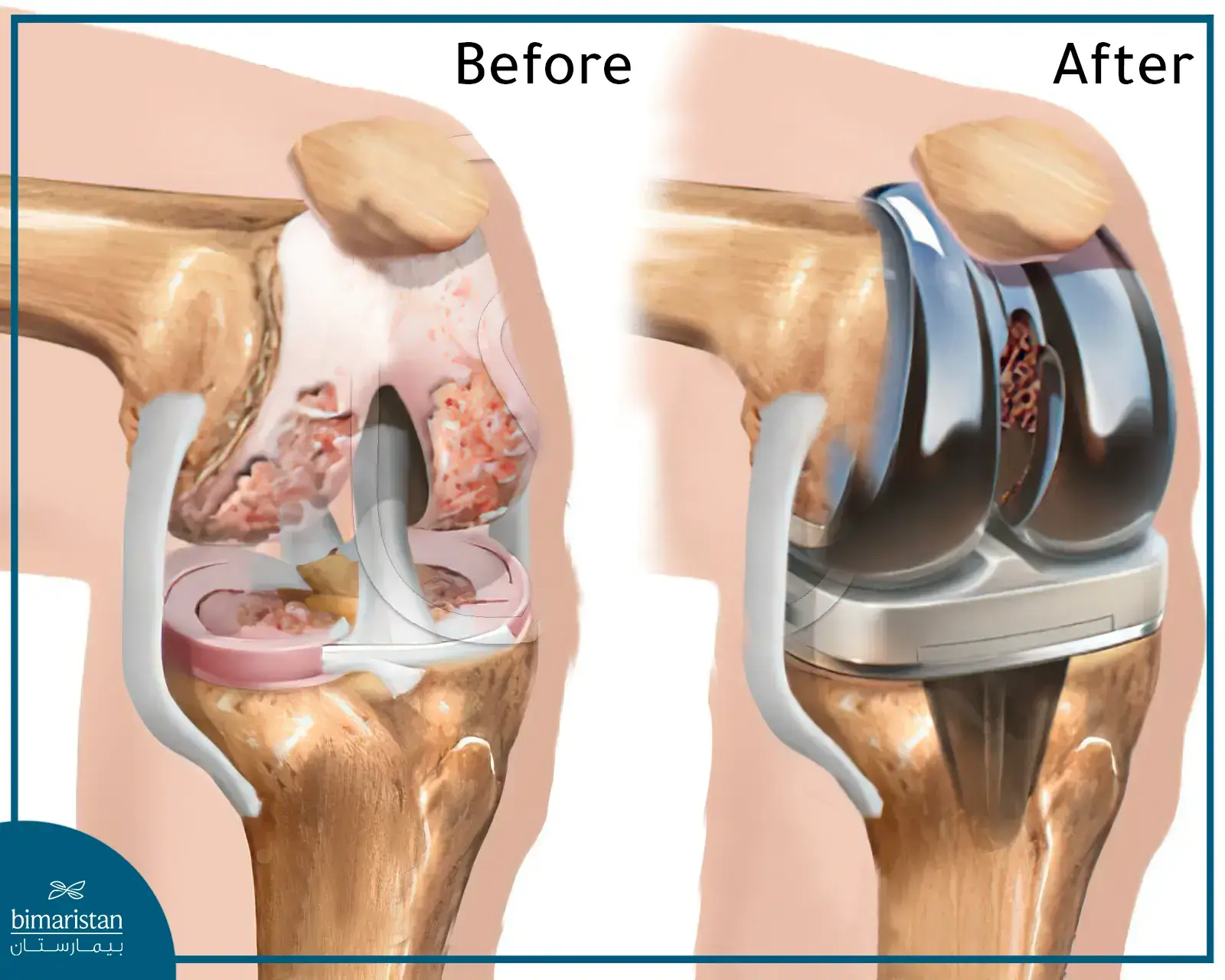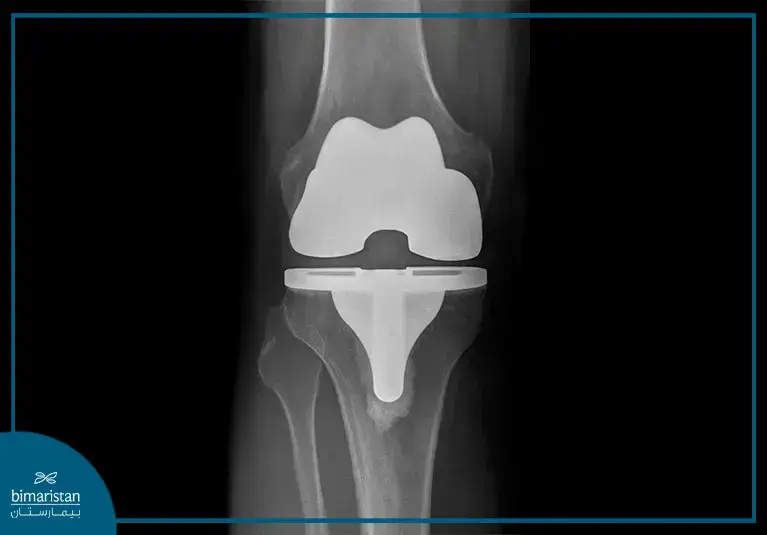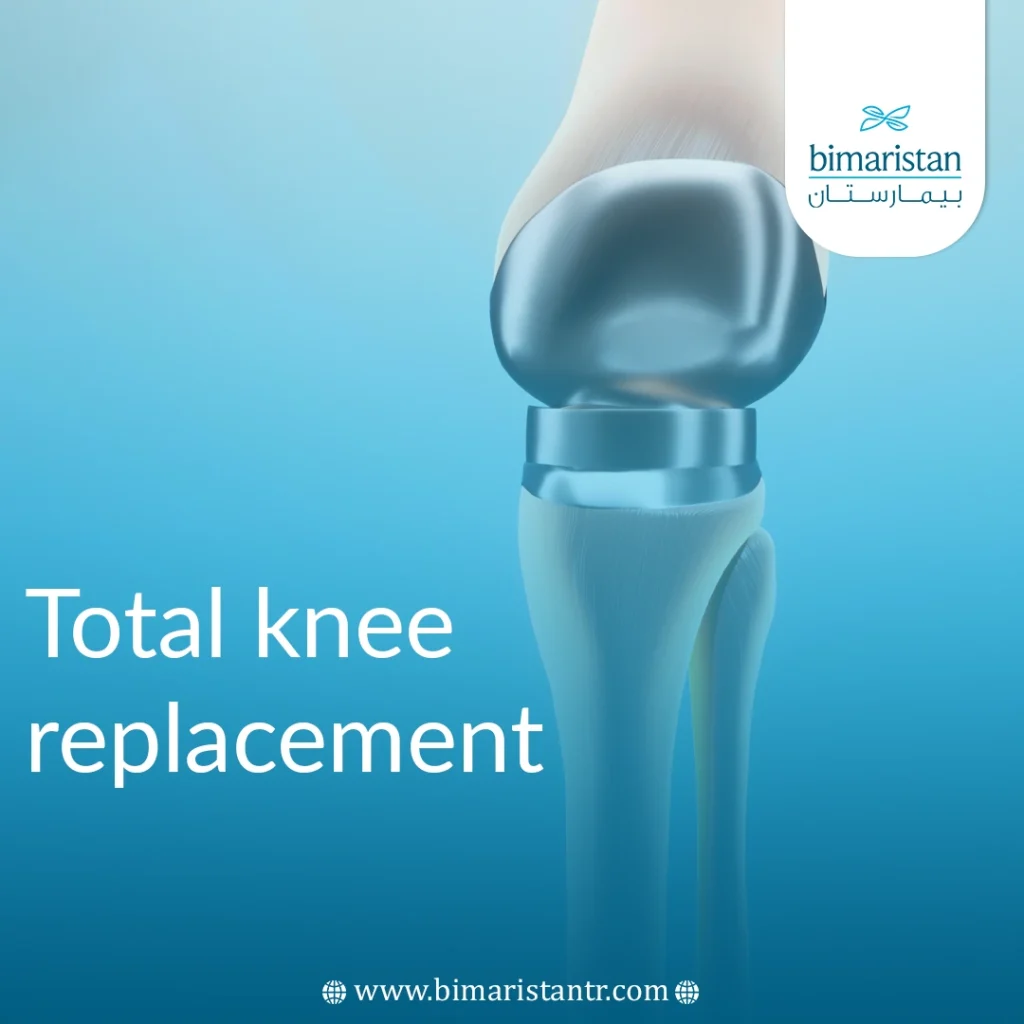Knee replacement surgery, also known as knee arthroplasty and rarely knee transplant, is a surgical procedure in which a damaged or diseased knee joint is replaced with an artificial joint. This procedure aims to relieve pain and improve knee function.
What is Knee Replacement Surgery?
Knee replacement surgery, also known as knee arthroplasty, is a surgical procedure in which a damaged or diseased knee joint is replaced with an artificial joint. This procedure aims to relieve pain and improve knee function.
Causes of Knee Replacement Surgery
End-stage degenerative arthritis of the knee is the primary and most common reason for knee replacement surgery. Approximately 94-97% of knee replacement surgeries are performed due to primary or post-traumatic degenerative arthritis. Candidates for this surgery typically suffer from degenerative changes accompanied by pain and restricted knee function that do not respond to conservative (non-surgical) treatments. The need for total knee replacement (TKR) (or total knee arthroplasty) arises due to several key reasons:
- Osteoarthritis: The most common cause is where the cartilage covering the joint wears away, leading to pain, stiffness, and difficulty in movement.
- Rheumatoid arthritis: An autoimmune disease causing inflammation and damage to the joints.
- Severe knee injuries, Such as fractures or ligament tears, do not respond to other treatments.
- Inflammatory arthritis
- Traumatic injuries
- Inflammatory joint diseases
- Osteochondroma
- Nodular synovitis
- Metabolic arthritis
- Avascular necrosis
- Gout and pseudogout
- Post-traumatic arthritis
- Intra-articular fractures
Forms of Arthritis in the Knee
Arthritis is one of the major bone problems worldwide. There are two main types of knee arthritis: degenerative arthritis (osteoarthritis) and rheumatoid arthritis
Degenerative Arthritis (Osteoarthritis)
Degenerative arthritis, also known as osteoarthritis or joint wear, is a chronic condition that affects the joints and leads to cartilage erosion. Cartilage is the slippery tissue that covers the ends of bones and helps them move smoothly. As the cartilage wears away, the bones rub against each other, causing pain, stiffness, swelling, and difficulty in movement.
In the degenerative form, the cartilage becomes stiff, reducing its elasticity and increasing the likelihood of damage. The cartilage in the knee joint acts as a shock absorber, and as it gradually wears away, the damaged cartilage and ligaments become strained, causing pain. Eventually, the bones in the knee joint come into contact with each other, leading to severe pain. This is commonly observed in the elderly.

Rheumatoid Arthritis
Rheumatoid arthritis is a chronic and debilitating autoimmune disease in which the body’s immune system attacks its tissues, particularly the joints. This attack leads to inflammation, swelling, and joint pain, affecting a person’s ability to move and perform daily activities.
Rheumatoid arthritis commonly affects women aged 40-60 years. In this condition, the synovial membrane becomes inflamed, causing swelling and pain in the knee joint. If left untreated, it can deform the affected knee joint.
Patients suffering from both forms of arthritis can benefit from knee replacement surgery. Traumatic injuries from accidents may also necessitate knee replacement surgery depending on the type of fracture and the amount of bone loss in the joint at the time of the injury.
Knee replacement surgery is very effective in improving health-related quality of life, with some exceptions in the social aspect. It should be noted that patients who are less satisfied with knee replacement surgery tend to have mild complaints before the surgery. Therefore, all conservative treatment methods should be exhausted before surgical intervention.
Types of Knee Prostheses
Knee prostheses are typically made from a combination of durable materials designed to withstand pressure and continuous movement in the joint. Different types of knee prostheses are categorized based on the materials used to construct the components of the knee joint:
Metal-on-Polyethylene Knee Prosthesis
This type is the most common among knee prostheses. It comprises a metal femoral component attached to a polyethylene (plastic) spacer pre-attached to the tibial component. The metals used in this type include:
- Cobalt
- Chromium
- Titanium
- Zirconium
- Nickel
The metal-on-plastic prosthesis is the least expensive and has the most reliable studies regarding safety and longevity. However, one potential issue with this type is the immune reaction to small particles present in it, which can cause bone damage and surgery failure. Significant advancements in the manufacturing of this type have greatly reduced the wear rate.
Ceramic-on-Polyethylene Knee Prosthesis
This type uses a ceramic femoral component instead of metal, with a plastic spacer in between. It is used for individuals with allergies to nickel found in metal prostheses. Plastic particles of this type can also trigger an immune reaction.
Ceramic-on-Ceramic Knee Prosthesis
Both the femoral and tibial components are made of ceramic. Ceramic parts are less likely to react with the body. However, ceramic prostheses can sometimes produce a squeaking sound when walking. In rare cases, they can shatter under extreme pressure, necessitating surgical removal.
Metal-on-Metal Knee Prosthesis
Both the femoral and tibial components are made of metal. The use of this type has declined in recent years due to concerns about tiny metal particles leaking into the bloodstream. All-metal prostheses were initially developed to provide long-lasting alternatives for younger patients. However, the fine metal particles can cause inflammation, pain, and possibly damage organs. Women of childbearing age cannot have this type of prosthesis due to unknown effects on the fetus.
Contraindications for Knee Replacement Surgery
Certain conditions must be recognized and considered before deciding on knee replacement surgery. Absolute contraindications for knee replacement operation include:
- Active knee infections
- Chronic infection
- Failure of the knee extension mechanism
- Severe vascular diseases
- Flexion deformity secondary to muscle weakness
- A well-functioning knee joint fusion
Relative contraindications, which may be subject to discussion, include medical conditions that prevent safe anesthesia, inadequate soft tissue coverage, morbid obesity, neuropathic joint disease, a history of osteomyelitis around the knee joint, and physical or psychological conditions that preclude proper rehabilitation.
Age is not a contraindication for surgery; patients of all ages can be suitable candidates for knee replacement surgery.
Preoperative Tips for Knee Replacement Surgery
Clinical evaluation before surgery is crucial in assessing the medical condition and determining the relative risks the patient might face. Preoperative planning begins with selecting a suitable candidate for a knee replacement transplant.
Patient expectations and general risk factors play a significant role in deciding whether to proceed with surgery. Inquiring about the patient’s complaints, quality of life, and clinical condition and conducting a thorough physical examination are fundamental aspects of the preoperative evaluation for joint replacement.
It’s essential to review the patient’s medication history and exclude sources of infections such as dental, skin, urinary, and respiratory infections. All patients undergo laboratory tests, electrocardiograms, and chest X-rays.
Patients should have high cardiovascular and pulmonary efficiency (since most are elderly) to endure anesthesia and the potential blood loss of 1000-1500 ml during knee replacement surgery.
Typically, a simple X-ray is sufficient for initial radiological evaluation and confirming the diagnosis or assessing the severity of the disease. However, magnetic resonance imaging (MRI) or computed tomography (CT) may be necessary in exceptional cases such as congenital patellar dislocation, post-traumatic deformities, severe deformities, tumors, and congenital anomalies.
Underlying bone diseases (asymptomatic) that might interfere with knee replacement outcomes should be investigated. Examples of these conditions include:
- Nerve entrapment affecting lower limb motor functions
- Adjacent degenerative arthritis
- Any inflammatory joint condition that may manifest post-surgery
- Any musculoskeletal disability affecting mobility post-surgery
- History of thromboembolism or predisposing factors for it
The physical examination should include assessing the joint’s range of motion, surrounding ligaments, circulation, and skin condition. Additionally, the alignment of the lower limbs, patellar stability, and gait analysis should be evaluated.
Selecting the correct size for the prosthesis is a crucial phase in preoperative planning. To improve outcomes and increase satisfaction post-surgery, the expectations of both the patient and the surgeon should be considered. Planning the bone cuts can simplify the joint replacement procedure.
The surgeon’s goal during surgical planning is to achieve optimal prosthesis placement and limb alignment, achievable through three-dimensional thinking. Preoperative prediction of the surgical course should enhance the procedure’s accuracy, shorten its duration, and reduce complication rates.
The Procedure of Knee Replacement Surgery
During a knee replacement surgery, the damaged parts of the bones and cartilage are replaced with an artificial joint consisting of metal and plastic components to restore knee movement and function. In most current procedures, the prosthetic components are fixed using a bonding cement.
The artificial joint implanted during knee replacement surgery consists of three parts:
- Femoral Component: This metal part replaces the femur’s weight-bearing surface and includes a groove for the patella to move along.
- Patellar Component: A plastic button is attached to the back of the patella, allowing for smoother movement along the femoral component.
- Tibial Component: This part includes a metal tray attached to the tibia (shinbone) with a polyethylene (plastic) insert that creates a smooth surface for the femoral component to move on during knee motion.

To prevent bleeding, a tourniquet is applied around the upper thigh during knee replacement surgery. A surgical incision is made at the front of the knee, exposing the ends of the femur and tibia. The damaged portions of these bones are then removed, creating space for the metal and plastic components of the artificial joint.
Balancing the knee ligaments to correct any deformity is crucial to the surgery. The artificial joint components are then placed into the knee and tested for movement and stability. After confirming proper function, the surgical incision is closed. The entire knee replacement procedure typically takes about 1-2 hours.
Post-Operative Care for Knee Replacement Surgery
Depending on various factors, patients usually must stay in the hospital for one night after total knee replacement surgery. However, some patients may be eligible to go home the same day if they qualify for a recovery and rehabilitation program.

This day is extremely busy for the patient and their family, with many physical therapy instructions and nursing care provided quickly. Recommendations and guidelines are given to the patient before discharge from the hospital to home.
When Can the Patient Go Home? The patient can be discharged home when they can:
- Perform the home exercise program independently.
- Walk independently with the correct use of an assistive device (such as crutches or a cane).
- Get in and out of bed independently.
- Bathe and dress independently.
- Safely and correctly, go up and down stairs if necessary.
- Follow weight-bearing precautions as instructed by the surgeon.
- Enter and exit a car safely and correctly.
- Identify medications, understand their side effects, and when to take them.
- Care for the surgical site and dress themselves or with a family member’s help.
- Provide necessary home equipment and use it effectively.
Early Mobility After Knee Replacement Surgery
Early mobility is crucial in the recovery program after knee replacement surgery. Prolonged bed rest has harmful physiological effects, such as increased insulin resistance, muscle atrophy, decreased lung function, poor tissue oxygenation, and an increased risk of blood clots. Safe and effective pain management is essential to encourage early movement after surgery.
There is good evidence that early mobility facilitates recovery from knee replacement surgery. Recent analytical studies have shown a significant reduction in hospital stay duration (by 1.8 days) when patients mobilize within 24 hours of joint replacement surgery. Early mobility also helps improve functional recovery and reduce the incidence of deep vein thrombosis.
Prevention and Treatment of Nausea and Vomiting After Knee Replacement Surgery
Postoperative nausea and vomiting can be more bothersome than pain. Risk factors include being female, non-smoking status, and a history of motion sickness. Patients at risk should receive dexamethasone at the beginning of the surgery and a serotonin receptor antagonist at the end.
Pain After Knee Replacement Surgery
It is normal to experience pain, swelling, and even some bruising after surgery. The intensity and amount of pain will decrease over time, but pain and swelling may take up to six months to completely disappear.
A prescription for a range of pain relievers will be given before leaving the hospital to help manage pain after knee replacement surgery. The patient may be advised to take the following:
- A regular painkiller is to be taken for four days and then as needed.
- A stronger painkiller is to be taken every two hours as needed.
- A non-steroidal anti-inflammatory drug (like ibuprofen) must be taken regularly for four days.
Painkillers can be taken 30-45 minutes before physical therapy sessions, as some treatments and exercises can cause mild to moderate pain for a while. If pain persists, physical therapy may be halted.
Physical Therapy After Knee Replacement Surgery
The physical therapist will work on knee movement and walking exercises starting on the day of surgery. The therapist will teach the patient all the necessary precautions to ensure proper healing and improve the function of the new joint by walking with a walker or crutches after surgery.
The patient will be taught exercises to move the knee, techniques for transferring (getting in and out of bed), walking with a walker or crutches, stair climbing, and activities of daily living (such as dressing and bathing).
The physical therapist will guide the patient on how much body weight to put on the leg when standing up. Most patients can bear full body weight immediately after knee replacement surgery. The ability to bear weight is usually determined by the surgeons during the knee replacement procedure and remains unchanged for 6 weeks.
Home Physical Therapy After Knee Replacement Surgery
Some patients may attend special physical therapy sessions after being discharged home, while most can perform the exercise regimen independently. The basic home exercise program begins immediately after knee replacement surgery and aims to restore knee range of motion and strength. These exercises should be practiced before surgery to become familiar with them.
Diet After Knee Replacement Surgery
A healthy diet helps prepare the body for surgery. Good nutrition is necessary to heal and recover bones, muscles, and skin after knee replacement surgery. Well-nourished individuals are less likely to develop infections after joint replacement surgery.
Healthy nutrition involves including a source of protein, vegetables or fruits, and whole grains in every meal. Protein is particularly important after knee replacement surgery, as the need for protein increases, aiding in the healing process.
Complications of Knee Replacement Surgery
In a study conducted from 1990 to 2004 on 4 million patients who underwent knee replacement surgery, the overall complication rate associated with in-hospital procedures was 8.4%. Most complications were systemic (related to the patient’s body) rather than directly due to the replacement procedure.
In another cohort study on patients within 90 days after knee replacement surgery, it was found that 6.7% experienced new cardiac problems such as myocardial infarction, heart failure, or arrhythmias. Meanwhile, 4.9% experienced thromboembolic problems, such as deep vein thrombosis or pulmonary embolism.
The most common reasons for hospital readmission after knee replacement surgery were restricted knee movement (18.2%), wound complications (14%), joint infection (9.9%), bleeding (9.9%), and venous thromboembolism (3.3%).
Infection of the Prosthetic Joint After Knee Replacement Surgery
The infection rate of the prosthetic joint after knee replacement surgery is approximately 0.4-2%. Acute infections occur up to two months after surgery, subacute infections generally occur between two months and two years post-surgery, and late infections occur after more than two years.
Nerve Injury After Knee Replacement Surgery
Major nerves pass through all major joints, so there is a slight chance of injuring one of these nerves during or after joint surgery. If this happens after knee replacement surgery, it can lead to weakness or numbness in the lower leg and foot.
Polyethylene Wear in the Joint
This is a common late complication after knee replacement surgery, resulting from the mechanical wear process where the metal femoral component grinds against the polyethylene component.
Osteolysis After Knee Replacement Surgery
Osteolysis is one of the primary reasons for revision knee replacement surgery. It occurs in up to 16% of joint replacement surgeries using cement and between 6-30% in those not using cement.
Instability and Dislocation of the Knee Joint
This occurs due to abnormal and excessive displacement of the knee joint components and is one of the most common causes of early failure in knee replacement surgery. It usually requires revision surgery within four years after the initial replacement.
Outcomes After Knee Replacement Surgery
The life expectancy of the new knee joint after replacement surgery is influenced by the amount of stress placed on it. Controlling body weight and adhering to activity recommendations will extend the life of the knee joint. The artificial knee joint should typically last at least 15 years in 90% of cases.
Most patients show significant improvement in their knee condition after replacement surgery compared to their pre-surgery condition. However, 10-20% of patients exhibit some functional impairment or dissatisfaction despite the absence of surgical or technical complications.
Several patient-related factors may contribute to poor surgical outcomes after knee replacement, including obesity, comorbid conditions, and unrealistic expectations.
Failure of Knee Replacement Surgery
Up to 20% of patients undergoing knee replacement surgery may be dissatisfied with the results. However, revision surgery is not performed unless the cause of failure is understood. Over 90% of successful knee replacement surgeries typically last 10-15 years.
Obesity
Recent studies have found that obesity negatively affects knee replacement surgery outcomes, the complication rate, the longevity of the artificial knee, and the cost of the surgery. Obesity can increase the risk of superficial and deep infections of the surgical site, which is one of the most critical complications that can affect the success of the surgery. It can also contribute to longer hospital stays and increased medical costs following knee replacement surgery.
Comorbidities
With advancing age, the prevalence of comorbidities increases, which can negatively affect the outcomes of knee replacement surgery. These conditions lead to longer hospital stays, higher costs, poorer outcomes for the artificial knee, and lower patient satisfaction after surgery. Mental health issues such as preoperative anxiety and depression should also be considered, as they are known to contribute to dissatisfaction and poor outcomes following knee replacement surgery.
Post-Knee Replacement Surgery
Patient expectations significantly contribute to satisfaction after knee replacement surgery. Unrealistic or unachievable expectations can lead to patient dissatisfaction, regardless of the objective criteria for evaluating knee function. Discussing the general framework of knee replacement surgery is crucial to ensure appropriate expectations. Patients will inevitably be disappointed with the surgery results if they expect 100% pain relief, a return to high-level athletic performance, or the ability to squat and kneel without difficulty.
Success Rate of Knee Replacement Surgery in Turkey
Many studies show that 90-95% of total knee replacement surgeries are fully successful, with the prosthetic joint functioning well even 15 years post-surgery. Most patients walk without a cane, can climb stairs, get up from chairs normally, and resume their routine activities without problems or obstacles.
Cost of Knee Replacement Surgery in Turkey
Knee replacement surgery costs in Turkey vary depending on the type of prosthetic used, the surgeon’s expertise, and the quality of the hospital. The cost of replacing a single knee with the best type of prosthetic, such as the American ZIMMER, starts at around $7,000. This includes surgery performed under the supervision of a professor specializing in joint surgery and knee surgeons in Turkey using advanced techniques that require only a small incision, minimizing muscle damage.
The price may vary based on the patient’s condition, the technique used, and the type of prosthetic. Replacing both knee joints typically costs around $9,000.
| Type | One-Sided | Two-Sided |
|---|---|---|
| Stryker | $4,000 – $6,000 | $6,000 – $8,000 |
| Johnson & Johnson | $4,500 – $7,000 | $8,500 – $14,000 |
| Zimmer | $5,000 – $8,000 | $8,500 – $14,000 |
| Robotic-Assisted (Rosa) | $7,000 – $12,000 | $12,000 – $20,000 |
Post-Knee Replacement Surgery Tips
Patients should follow specific post-operative advice after knee replacement surgery:
- Use crutches or walking sticks initially.
- Try walking without assistance after about six weeks if you feel ready.
- Get up and walk for five minutes every hour to prevent blood clots.
- Do not sit with your legs crossed for the first six weeks.
- Wait at least six weeks before driving again if you had a total knee replacement or three weeks if you had a partial knee replacement.
- Avoid twisting your knee and excessive bending.
- Follow the exercises recommended by the physical therapist.
- Keep your leg elevated as much as possible to reduce swelling.
- Return to work when you feel ready—typically around 6 to 12 weeks, depending on your work.
- Do not sleep with a pillow under your knee (no special sleeping position is necessary after the surgery).
- Do not kneel on your new knee until your doctor says it is safe.
- Avoid household tasks involving lifting or moving anything heavy during the first three months.
An Alternative to Knee Joint Replacement Surgery
Choosing a knee joint replacement surgery depends on many factors, including:
The extent of damage to the joint
Its location and intensity
A Video Showing Knee Replacement Surgery
Contact Us
Contact us at Bimarstat, where we offer comprehensive medical services in orthopedics and joint surgery, including knee replacement surgeries. Our team consists of highly experienced specialists, and we use the latest technologies and equipment to ensure the best outcomes for our patients.
You can reach us through:
Phone: 00905010941111
We are pleased to offer you a free medical consultation to assess your condition and determine if knee replacement surgery is the right option for you. We will discuss all the details related to the surgery, including the risks, benefits, and expected costs. Do not hesitate to contact us if you need assistance. We are here to help you restore your health and activity.
Resources:
- Omar Hussain et al. Implant materials for knee and hip joint replacement: A review from the tribological perspective. IOP Conf. Series: Materials Science and Engineering. 2019, 561;012007.
- Erdogan et al. Preoperative Planning of Total Knee Replacement. InTech. 2013.
- Varacallo M. Total Knee Replacement (TKR) Techniques – StatPearls – NCBI Bookshelf. 2019.
- Dooley P, Secretan C. Total knee replacement: Understanding patient-related factors. BC medical journal 2016; 58:9.
- Omar Alshadokhi et al. Knee Replacement Surgery and Its Effect on Long Term. The Egyptian Journal of Hospital Medicine 2018;70 (2):187-191.
- Outpatient Hip and Knee Replacement Information Manual. Winnipeg Regional Health Authority 2020.
- Gorab R et al. The Total Knee Replacement Patient Manual. Orthopaedic Specialty Institute. 8th edition 2020.
- Soffin E. M, YaDeau J. T. Enhanced recovery after surgery for primary hip and knee arthroplasty: a review of the evidence. British Journal of Anaesthesia 2016;117:62–72.
- Mulcahy H, Chew F.S. Current Concepts in Knee Replacement: Complications. AJR 2014; 202: 76-86.



